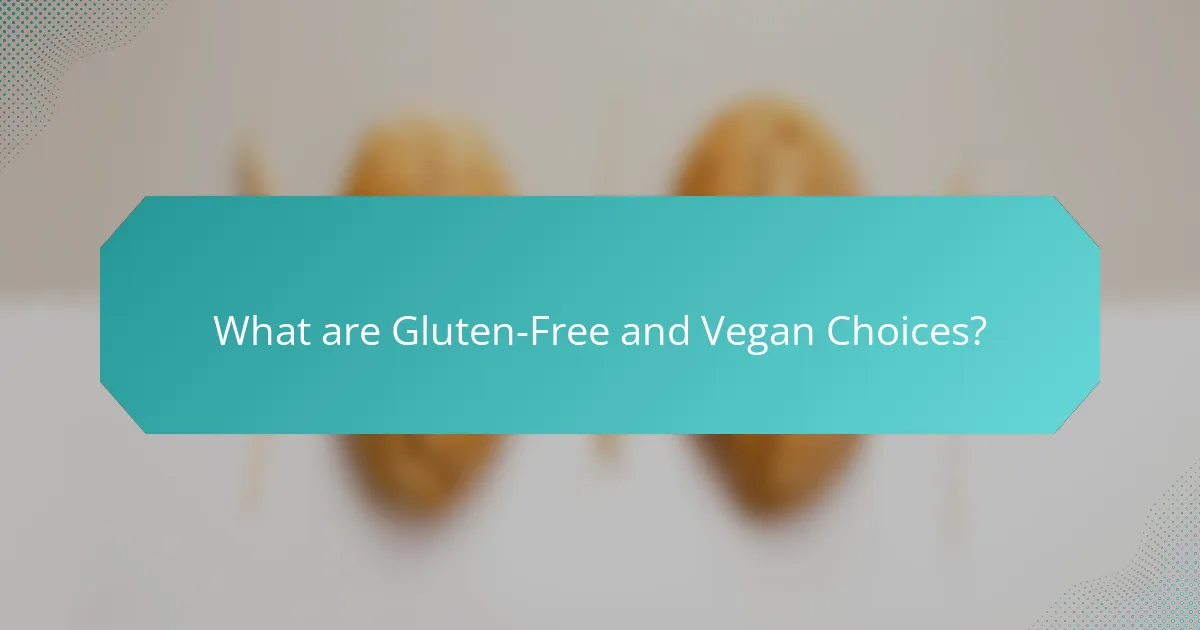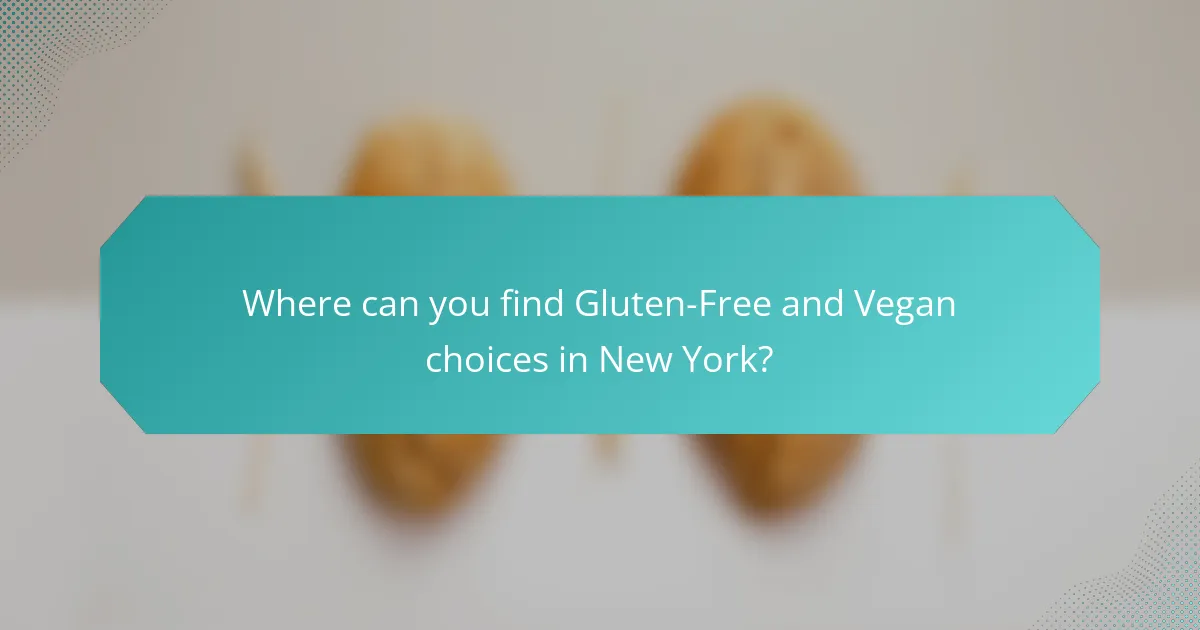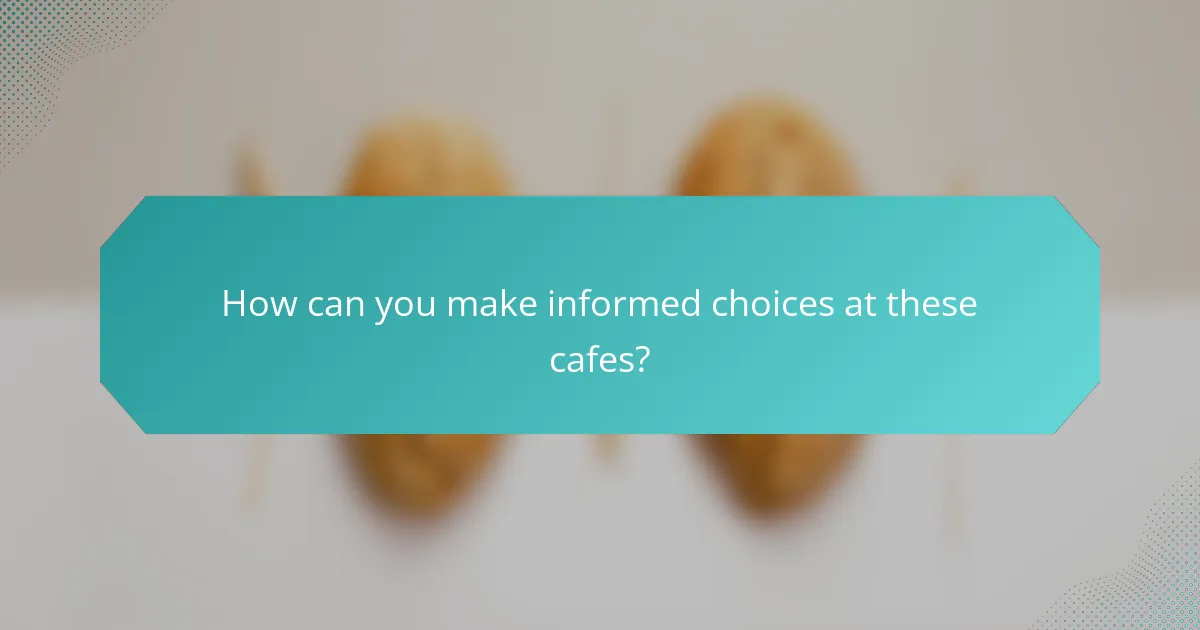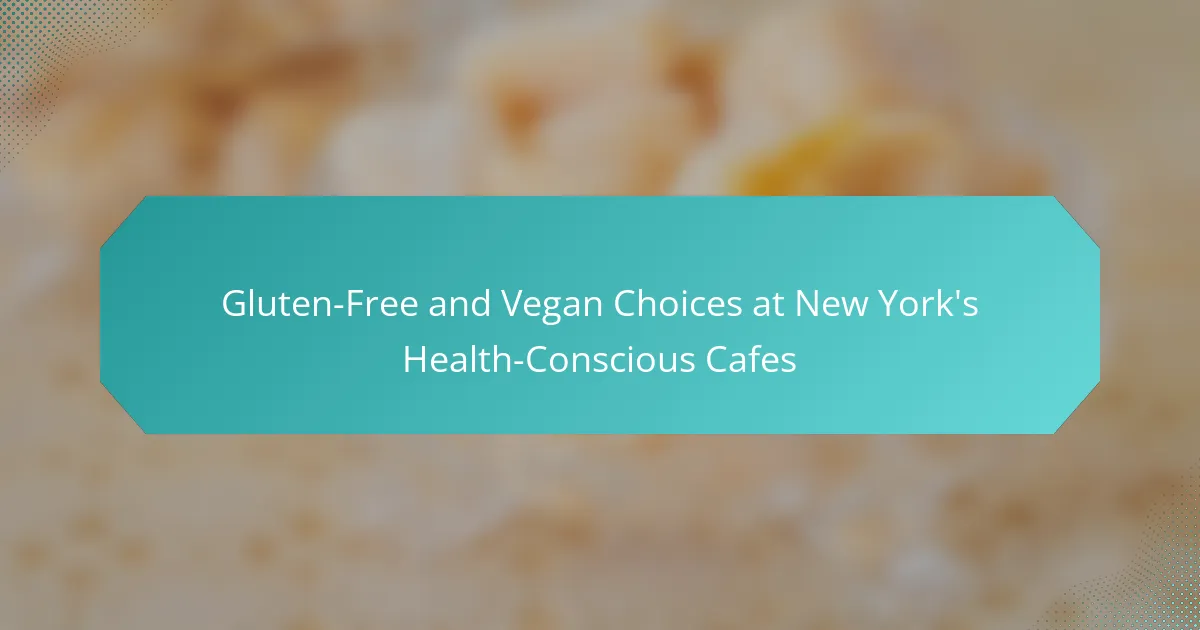Gluten-free and vegan choices are food options that exclude gluten, a protein found in wheat, barley, and rye, as well as all animal-derived ingredients. New York’s health-conscious cafes cater to these dietary preferences by offering a variety of nutrient-rich dishes, such as quinoa salads, vegetable stir-fries, and plant-based smoothies. Notable establishments like By Chloe, Hu Kitchen, and Peacefood Cafe provide diverse menus that highlight gluten-free grains and plant-based proteins. To ensure safe dining experiences, customers are encouraged to review menus for gluten-free and vegan labels, inquire about ingredient sourcing, and check for potential cross-contamination.

What are Gluten-Free and Vegan Choices?
Gluten-free and vegan choices are food options that do not contain gluten or animal products. Gluten is a protein found in wheat, barley, and rye. Vegan diets exclude all animal-derived ingredients, including meat, dairy, and eggs. Many health-conscious cafes in New York offer dishes that cater to these dietary restrictions. Examples include quinoa salads, vegetable stir-fries, and plant-based smoothies. These options are often rich in nutrients and can be satisfying alternatives. Cafes may also use gluten-free grains like rice or buckwheat in their recipes. This ensures that customers with gluten sensitivities or vegan preferences have diverse meal choices.
How do Gluten-Free and Vegan diets differ from traditional diets?
Gluten-free and vegan diets differ from traditional diets primarily in their exclusion of certain food groups. Gluten-free diets eliminate all foods containing gluten, a protein found in wheat, barley, and rye. This is essential for individuals with celiac disease or gluten sensitivity. Vegan diets avoid all animal products, including meat, dairy, and eggs. This choice is often motivated by ethical, environmental, or health considerations. Traditional diets typically include a variety of animal products and gluten-containing grains. Research indicates that gluten-free diets can lead to improved digestive health for those with gluten intolerance. Vegan diets are associated with lower risks of heart disease and obesity due to their high fiber content and lower saturated fat levels.
What are the key components of a Gluten-Free diet?
A gluten-free diet primarily excludes all foods containing gluten. Gluten is a protein found in wheat, barley, and rye. Key components of a gluten-free diet include fruits, vegetables, meat, fish, dairy, and gluten-free grains. Common gluten-free grains are rice, quinoa, and corn. Processed foods must be checked for hidden gluten. Cross-contamination with gluten-containing foods should be avoided. Many gluten-free products are available in stores. Adopting a gluten-free diet can aid those with celiac disease or gluten sensitivity.
What are the essential elements of a Vegan diet?
A Vegan diet consists primarily of plant-based foods. Essential elements include fruits, vegetables, whole grains, legumes, nuts, and seeds. These foods provide necessary nutrients like vitamins, minerals, and protein. A Vegan diet excludes all animal products, including meat, dairy, and eggs. This dietary choice is often linked to health benefits such as lower cholesterol and reduced risk of chronic diseases. Research indicates that a well-planned Vegan diet can meet nutritional needs effectively. The Academy of Nutrition and Dietetics supports Vegan diets for all life stages, highlighting their healthful nature.
Why are Gluten-Free and Vegan options popular in New York’s health-conscious cafes?
Gluten-free and vegan options are popular in New York’s health-conscious cafes due to rising health awareness. Many consumers prioritize diets that exclude gluten and animal products for health benefits. Research indicates that gluten-free diets can alleviate symptoms for those with gluten sensitivities. Vegan diets are associated with lower risks of chronic diseases, promoting overall wellness. Additionally, the trend aligns with sustainability values, appealing to environmentally conscious consumers. Cafes cater to these preferences to attract a broader clientele. The demand for such options reflects changing food culture in urban areas.
What health benefits do Gluten-Free and Vegan diets provide?
Gluten-free and vegan diets provide several health benefits. These diets can reduce the risk of chronic diseases. They often lead to lower cholesterol levels. A gluten-free diet is essential for individuals with celiac disease. It helps prevent gastrointestinal damage in these individuals. Vegan diets are linked to lower blood pressure. They can also aid in weight management. Studies show that plant-based diets improve heart health. A vegan diet is rich in antioxidants and nutrients. This can enhance overall well-being.
How do cultural trends influence the demand for these options?
Cultural trends significantly influence the demand for gluten-free and vegan options at New York’s health-conscious cafes. Increasing awareness of health and wellness drives consumers to seek out these dietary choices. Social media platforms amplify trends, making gluten-free and vegan lifestyles more visible. Influencers and celebrities endorsing these diets further boost their popularity. Research indicates that 30% of Americans are reducing gluten intake, reflecting a shift in dietary preferences. Additionally, the rise of environmental consciousness makes plant-based diets more appealing. As a result, cafes adapt their menus to meet this growing consumer demand.

Where can you find Gluten-Free and Vegan choices in New York?
You can find gluten-free and vegan choices in New York at various health-conscious cafes. Popular spots include By Chloe, which offers a fully vegan menu with gluten-free options. Another option is Hu Kitchen, known for its clean-eating philosophy and gluten-free dishes. Additionally, Peacefood Cafe provides a range of vegan and gluten-free meals. These establishments prioritize healthy ingredients and cater to dietary restrictions. Their menus often highlight gluten-free grains and plant-based proteins. Each cafe ensures that customers can enjoy flavorful meals without compromising their dietary needs.
What are some popular health-conscious cafes offering these options?
Popular health-conscious cafes in New York offering gluten-free and vegan options include By Chloe, Le Pain Quotidien, and The Butcher’s Daughter. By Chloe is known for its plant-based menu and gluten-free choices. Le Pain Quotidien provides organic ingredients and a variety of vegan dishes. The Butcher’s Daughter specializes in vegetarian and vegan cuisine, with gluten-free options available. These cafes cater to health-conscious individuals seeking nutritious meals.
Which cafes are known for their innovative Gluten-Free and Vegan menus?
Some cafes known for their innovative gluten-free and vegan menus include By Chloe, Modern Love, and Peacefood Cafe. By Chloe offers a variety of plant-based dishes that are both gluten-free and vegan. Modern Love specializes in gourmet vegan comfort food, with many gluten-free options available. Peacefood Cafe features a diverse menu with a strong emphasis on both gluten-free and vegan meals. These establishments consistently receive positive reviews for their creative offerings and commitment to health-conscious dining.
How do these cafes ensure their offerings meet dietary needs?
These cafes ensure their offerings meet dietary needs by carefully selecting ingredients that cater to various dietary restrictions. They often provide clear labeling on menus to indicate gluten-free and vegan options. Many cafes collaborate with nutritionists to develop recipes that meet specific dietary guidelines. They also train staff to understand dietary needs and cross-contamination risks. Regular feedback from customers helps cafes adjust their offerings. Some cafes conduct regular audits of their suppliers to ensure ingredient quality. Additionally, they may offer customizable menu items to accommodate individual preferences. These practices help create an inclusive dining experience for all customers.
What are the characteristics of a good health-conscious cafe?
A good health-conscious cafe prioritizes nutritious food options and sustainable practices. These cafes often feature organic ingredients sourced from local farms. They provide a diverse menu that includes gluten-free and vegan choices. Transparency in ingredient sourcing and nutritional information is essential. A welcoming atmosphere promotes community engagement and wellness. Additionally, they usually offer beverages like cold-pressed juices and herbal teas. Many health-conscious cafes emphasize eco-friendly packaging and waste reduction. Customer feedback is often actively sought to improve offerings and services.
How do cafes source their ingredients for Gluten-Free and Vegan dishes?
Cafes source their ingredients for gluten-free and vegan dishes through local suppliers and specialty distributors. They prioritize fresh, organic produce to ensure quality. Many cafes establish relationships with local farms for seasonal ingredients. They also seek certified gluten-free and vegan products from trusted brands. Some cafes conduct thorough ingredient checks to avoid cross-contamination. They may participate in food co-ops for sustainable sourcing. Additionally, cafes often utilize online platforms to find niche suppliers. This approach supports the growing demand for gluten-free and vegan options.
What certifications should you look for in a cafe’s menu?
Look for certifications such as USDA Organic, Non-GMO Project Verified, and Gluten-Free Certification Organization. USDA Organic ensures that ingredients are grown without synthetic pesticides or fertilizers. Non-GMO Project Verified indicates that products do not contain genetically modified organisms. Gluten-Free Certification Organization certification confirms that food is safe for those with gluten sensitivities. These certifications provide assurance about ingredient quality and safety. They also reflect the cafe’s commitment to health-conscious practices.

How can you make informed choices at these cafes?
To make informed choices at health-conscious cafes, review the menu carefully. Look for labels indicating gluten-free and vegan options. Ask staff about ingredient sources and preparation methods. Inquire about cross-contamination with gluten or animal products. Check for certifications or third-party verifications of gluten-free and vegan claims. Research the cafe’s reputation online for customer reviews and experiences. Utilize apps that provide information on gluten-free and vegan dining options. These steps increase the likelihood of making choices that align with dietary needs.
What should you consider when selecting Gluten-Free and Vegan options?
When selecting gluten-free and vegan options, consider ingredient sourcing and cross-contamination. Gluten-free items must not contain wheat, barley, or rye. Vegan options should exclude all animal products, including dairy and eggs. Check labels for hidden gluten sources like malt or modified food starch. Ensure preparation areas are free from gluten exposure to avoid cross-contamination. Nutritional value is also important; focus on whole foods for better health benefits. Research shows that gluten-free diets can improve symptoms for those with celiac disease. Vegan diets are linked to lower risks of heart disease and obesity.
How can you identify hidden gluten or animal products in meals?
To identify hidden gluten or animal products in meals, read ingredient labels carefully. Many processed foods contain gluten or animal-derived ingredients. Look for terms like wheat, barley, and rye to spot gluten. For animal products, check for terms like gelatin, casein, and lard. Cross-contamination can also occur in kitchens. Ask staff about food preparation methods. Some ingredients may not be obvious, such as certain flavorings or sauces. Research shows that about 20% of gluten-sensitive individuals react to trace amounts of gluten. Being vigilant helps ensure compliance with dietary restrictions.
What tips can help you enjoy a satisfying meal while staying within your dietary restrictions?
Focus on whole, plant-based foods. Incorporate fruits, vegetables, legumes, and whole grains. These ingredients provide essential nutrients and fiber. Experiment with herbs and spices for flavor enhancement. This approach keeps meals interesting and satisfying. Plan meals ahead to ensure variety and balance. Use gluten-free grains like quinoa or brown rice. Choose cafes that specialize in gluten-free and vegan options. Reading menus carefully helps identify suitable choices.
What are some common misconceptions about Gluten-Free and Vegan diets?
One common misconception about gluten-free diets is that they are inherently healthy. Many gluten-free products are processed and high in sugar. Another misconception is that all vegan diets provide complete nutrition. Some vegan diets can lack essential nutrients like Vitamin B12 and protein if not properly planned. Additionally, many believe gluten-free and vegan diets are the same, but they cater to different dietary needs. Gluten-free diets are for those with gluten intolerance or celiac disease, while vegan diets exclude all animal products. Lastly, people often think gluten-free and vegan foods are always tasteless. However, many health-conscious cafes in New York offer flavorful options that challenge this belief.
Why do some people believe Gluten-Free diets are healthier for everyone?
Some people believe gluten-free diets are healthier for everyone due to misconceptions about gluten and health. They often associate gluten with various health issues, even in individuals without celiac disease or gluten sensitivity. This belief is reinforced by the rise of gluten-free products marketed as healthier options. Many perceive gluten-free foods as more natural or less processed. Additionally, some studies suggest that gluten-free diets may lead to increased consumption of fruits and vegetables. However, research shows that gluten is safe for most people. A balanced diet is generally more important than eliminating gluten.
How can Vegan diets provide sufficient nutrition without animal products?
Vegan diets can provide sufficient nutrition without animal products by focusing on a variety of plant-based foods. These diets include fruits, vegetables, grains, legumes, nuts, and seeds. Each of these food groups offers essential nutrients. For example, legumes are rich in protein and iron. Whole grains provide fiber and B vitamins. Nuts and seeds are excellent sources of healthy fats and vitamin E.
Additionally, fortified foods can help meet nutritional needs. Fortified plant milks often contain calcium and vitamin D. Nutritional yeast is a good source of vitamin B12. Research indicates that well-planned vegan diets can meet all nutritional requirements. A study published in the Journal of the American Dietetic Association found that vegan diets can support healthy growth and development in children.
With careful planning, a diverse vegan diet can be nutritionally adequate and beneficial for health.
What are the best practices for navigating Gluten-Free and Vegan choices?
To navigate gluten-free and vegan choices effectively, prioritize reading labels carefully. Many packaged foods contain hidden gluten or animal products. Next, opt for whole foods like fruits, vegetables, and grains that are naturally gluten-free and vegan. Research restaurants in New York that specialize in gluten-free and vegan menus. Look for cafes that clearly mark their dishes to avoid cross-contamination. Communicate dietary restrictions with staff to ensure your meal meets your needs. Familiarize yourself with gluten-free grains such as quinoa and rice, which can serve as substitutes. Lastly, consider meal prepping to have ready-to-eat options at home. These practices enhance your dining experience while adhering to dietary preferences.
Gluten-free and vegan choices represent dietary options that exclude gluten and animal products, respectively. This article explores the characteristics and health benefits of these diets, highlighting their growing popularity in New York’s health-conscious cafes due to rising health awareness and sustainability trends. It details the key components of gluten-free and vegan diets, identifies popular cafes that cater to these preferences, and discusses best practices for navigating menu options. Additionally, it addresses common misconceptions and provides tips for making informed dietary choices while enjoying flavorful meals.
